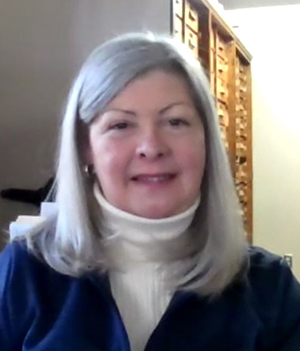Faculty Profile
Susan Anagnost


Emeritus
Department of Sustainable Resources Management
101 Baker Lab
Director
Professor Emeritus and Visiting Professor
Director, Tropical Timber Information Center
Department of Sustainable Resources Management
Education
Ph.D., SUNY-Environmental Science and Forestry, 1990
M.S., SUNY-ESF
B.A., Gettysburg College
Areas of Study
Wood anatomy and ultrastructure
Decay of wood products
Mycology of indoor air
Light microscopy, scanning and transmission electron microscopy
Tropical Timber Information Center
The Tropical Timber Information Center (TTIC) was established in 1957 at the request of industry to provide information on wood properties and uses for domestic and tropical species. The center is home to the Harry Phillip Brown Memorial Wood Collection, which includes 40,000 wood samples from South and Central America, Asia, Africa, Europe, and North America. These samples are used for wood identification and anatomy research, and the samples can be shared with researchers around the world.
Blog Tropical Timber Information Center – NC Brown Center for Ultrastructure Studies (wordpress.com)
Webpage: Tropical Timber Information | SRM | SUNY ESF
The Tropical Timber Information Center (TTIC) provides wood identification services and information on the properties and uses of tropical and domestic woods. Accurate identification of imported timbers helps to insure authenticity for proper wood utilization. Tropical species imported into the US include such woods as Balsa, Cedro, Ipé (Brazilian walnut), Jatoba (Brazilian cherry), Keruing (Apitong), Mahogany, Meranti (Lauan), Sapele, and Teak to name a few. Uses include flooring, decking, interior finishing, cabinetry and plywood.
TTIC is the home of the Harry Philip Brown Memorial Wood Collection, a repository of about 40,000 wood samples from Africa, Asia, Europe, North America and South America. Unique to this collection is the Project 1 North American Wood Collection which contains wood specimens collected from about 780 trees throughout the US and Canada.
TTIC provides:
- Wood identification for both tropical and domestic woods
- Information on properties and uses of imported timbers as well as domestic species
- Authenticated wood samples for loan to researchers
- Over 5,000 microscope slides of wood samples for loan to researchers
- Digital images of wood anatomical features
- scanning electron micrographs of domestic woods
- light micrographs in progress
- Project 1 North American wood samples are available for research/wood collections
- Imaging: Light microscopy, Scanning EM and Transmission EM of wood samples is available in nearby facilities: the NC Brown Center for Ultrastructure Studies and Analytical and Technical Services
- Wood property testing available in the Wood Products Engineering Laboratory
NCB Center for Ultrastructure Studies
NC Brown Center for Ultrastructure Studies N.C. Brown Center for Ultrastructure Studies | SRM | SUNY-ESF
NCB Blog: https://ncbrownultrastructure.wordpress.com/
Courses Taught
MCR 480/680 Fundamentals of Microscopy
MCR 484/783 Scanning Electron Microscopy
MCR 485/683 Transmission Electron Microscopy
MCR 580 Microtechnique
MCR 585 Light Microscopy
RMS 387/587 Renewable Materials for Sustainable Construction (teach1/3 of course)
RMS 376 Decay of Wood Products
Other teaching experience: Wood Structure and Properties; Wood Identification; Fiber Identification; Anatomy and Ultrastructure of Wood
Selected Publications
Crawford, Judith A.; Rosenbaum, Paula F.; Anagnost, Susan E.; Hunt, Andrew; Abraham, Jerrold L. 2015. Understanding the conditions that affect indoor fungal exposures. Science of the Total Environment 517:113-124.
Rosenbaum, PF, Crawford JA, Anagnost SE, Wang CJK,, Hunt A, Anbar RD, Hargrave TM, Hall GE, Liu CC, Abraham JL. 2010. Indoor airborne fungi and wheeze in the first year of life among a cohort of infants at risk for asthma. Journal Exposure Science and Environmental Epidemiology, 20:503-515; (September-October) 2010.
Anagnost, S.E. 2007. Wood in the Built Environment – Conditions for Mold and Decay, In: Sampling and Analysis of Indoor Microorganisms, Editors, C. S. Yang and P. Heinsohn, John Wiley & Sons, Inc., Hoboken, New Jersey.
Catranis, C.M., Anagnost, S.E., Zhang, L., Fernando, A., Morey, S., Zhou, S., and C.J.K Wang. 2006. A new sub-sampling method for estimating total colony forming units per cubic meter. Aerobiologia 22:177-184.
Anagnost, S.E., Zhou, S., Yeo, H. Wang, C.J.K., Smith, W.B. and D.M. Roberts. 2006. Fungi inhabiting southern pine utility poles during manufacture. Forest Products Journal 56(1):53-59.
Fernando, A.A., Anagnost, S.E., Zhou, S., Morey, S.R., and C.J.K. Wang. 2005. Noteworthy fungi from air samples. Mycotaxon 92:322-338.
Anagnost, S.E., Mark, R. M. and R. B. Hanna. 2005. S2 Orientation of Microfibrils in Softwood Tracheids and Hardwood Fibers. International Association of Wood Anatomists Journal 26(3):325-338.
Catharine M. Catranis, Susan E. Anagnost, Analie Fernando, Shannon Morey, C. J. K. Wang, Lianjun Zhang, Analie Fernando, Shannon Morey, Paula DeStefano, Christopher Garback, Melanie LaMoy, Geralyn Hall, Deepa Naishadham, Judith Crawford, Andrew Hunt, and Jerrold L. Abraham. 2005. Assessment of Exposure to Indoor Environmental Factors for an Infant Cohort at Risk for Asthma: Preliminary analysis of Bioaerosol Data In: Bioaerosols, Fungi, Bacteria, Mycotoxins and Human Health, Editor, E. Johanning. Fungal Research Group Foundation, Inc., Albany, New York. pp. 40-48.
Anagnost, S.E., Mark, R.E. and R.B. Hanna. 2002. Variation of microfibril angle within individual fibers. Wood and Fiber Science 34(2):337-349.
Anagnost, S.E., Mark, R.E. and R.B. Hanna. 2000. Utilization of soft rot cavity orientation for the determination of microfibril angle. Wood and Fiber Science 32(1):81-87.
Anagnost, S.E. 1998. Light microscopic diagnosis of wood decay. International Association of Wood Anatomists Journal 19(2):141-167.